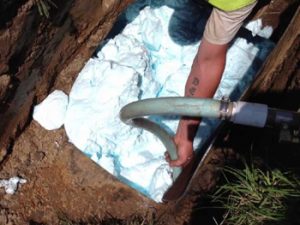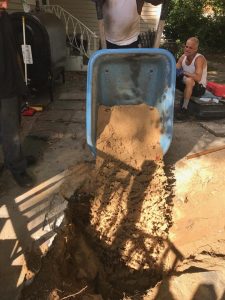Types of Oil Tank Abandonment on Long Island
There are two types of commonly used materials to abandon and decomission underground oil tanks: sand and foam. Oil tank abandonment is an effective way of deactivating an oil tank.
Abandonment offers several advantages including:
-Avoiding the cost of tank removal, including excavating and disposing of the tank.
-Tank abandonment allows your property to stay intact. The cost to replace the surface area is avoided, including paved areas, sidewalks, grass, and landscaping.
-Abandonment can be a time-efficient choice and can be done in as quickly as a day.
Oil tanks can be filled using two types of materials: foam and sand.
-
Foam Tank Abandonment
 Foam Abandonment is quick, safe, and cost-efficient way to properly abandon a tank. The Tripolymer Foam is non-flammable, will not leak into the soil, and does not require any hazardous excavation. It can safely reach the most inaccessible of tanks and is the most lightweight option for abandonment. Most tanks in Nassau and Suffolk counties that are less than 1,100 gallons can be filled with foam for tank abandonment. In these counties, the Tripolymer Foam can be used as an environmentally-safe option while leaving virtually no property damage. Foam additionally offers great flexibility if the oil tank is removed in the future for its lightweight nature.
Foam Abandonment is quick, safe, and cost-efficient way to properly abandon a tank. The Tripolymer Foam is non-flammable, will not leak into the soil, and does not require any hazardous excavation. It can safely reach the most inaccessible of tanks and is the most lightweight option for abandonment. Most tanks in Nassau and Suffolk counties that are less than 1,100 gallons can be filled with foam for tank abandonment. In these counties, the Tripolymer Foam can be used as an environmentally-safe option while leaving virtually no property damage. Foam additionally offers great flexibility if the oil tank is removed in the future for its lightweight nature.
To abandon a tank using foam, the ground is excavated to reach the top of the tank. Then the top of the tank is cut open to allow easy access within the tank. An approved waste oil company will vacuum clean the tank to ensure that all oil, water, or sludge residue is removed. The tank is set to dry and then it is completely filled with the Tripolymer foam which completely fills the tank without any pollution or contamination to the ground. Tripolymer foam also ensures excellent structural integrity, allowing the preservation of your property. After the tank is filled, the fill and vent pipes are removed, and any openings are concealed with cement to completely disable the use of the tank. A certificate of abandonment is issued after completion of the foam abandonment. Learn more about the cost of oil tank abandonment.
2. Sand Tank Abandonment
Sand abandonment is recommended when the property is located in an area of a high water table. Sand abandonment can be done by cutting the top of the tank off to expose the inside of the tank. Any excess sludge, oil, or water is removed with a vacuum cleaner and is disposed of within a licensed facility. Then, a licensed team enters the tank to completely clean the top, sides, and bottom of the tank before filling the tank completely with sand. The tank is then closed, the excavation is backfilled, and all pipes connected to the oil tank are removed. The fill and vents from the pipes are cemented shut when they are removed, and all openings are concealed to disable the tank. A certificate of abandonment is issued after the completion of the sand abandonment.


 Free, No Obligation Estimate
Free, No Obligation Estimate